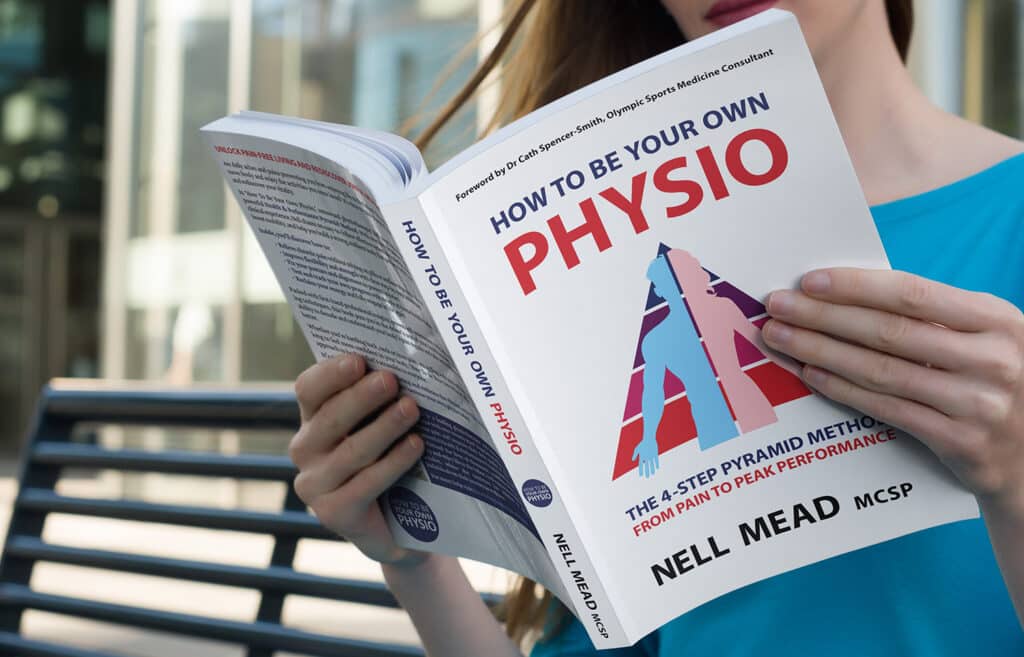The BBC recently reported that the waiting list for routine surgery in England could hit 10 million by the end of this year. More than 300,000 people have already been waiting for more than a year for routine surgery, which includes knee replacements, so it’s not surprising that more and more people are turning to the private sector, not only for the surgery but also for the physiotherapy that’s required to make a knee replacement really successful.
Tell me about knees
The knee is mostly a hinge joint, though unlike the hinge on a door, there’s also a bit of built-in rotation that allows it to “lock” into extension. It’s formed by the femur (thigh bone) and the tibia (shin bone). It’s directly impacted by the actions of the thigh and calf muscles, but also by the muscles that affect the other ends of the femur and tibia (the muscles of the hip and foot/ankle) because if the rotation of the femur or tibia is affected, then the alignment of the “hinge” will be impacted.
Unlike a door hinge, the knee also has a bony protector – the patella or kneecap, whose job is to add a bit of bulk to the front of the knee. This acts as a fulcrum for the quadriceps (front of thigh) muscles, giving them a greater mechanical advantage, so that they don’t have to be super bulky in order to produce the power to sprint, jump and kick.
Why might I be told I need a knee replacement?
We are able to replace knee joints when they are not fit for purpose. This could be due to an accident (for example, sometimes if you fracture the femur or tibia inside the knee joint, disrupting the cartilage) but more commonly, it’s due to osteoarthritis.
Osteoarthritis is essentially “wear and tear” to the hyaline cartilage that coats and protects the ends of the bones – the ends of the femur and tibia, and the back of the patella. There are many ways in which this cartilage can be damaged – and again these could be traumatic (for example, an old fracture in the knee joint, causing cartilage damage), overuse (this is very common in people who’ve played a lot of rugby and football as these sports require a lot of twisting, turning and contact, which place stress on the knee), underuse (couch potatoes and workaholics who sit in the same position all the time can create joint stiffness and “wear points” where the same bit of cartilage is constantly under strain) and misuse (for example, limping for long periods due to injury.) Osteoarthritis can be the outcome of any one or more of these issues.
Having said that, most of us over the age of about 30 are walking around with some degree of osteoarthritis somewhere! Just because you have some wear and tear in your joints, it does not automatically mean that you need a joint replacement. I was diagnosed with arthritis in my right shoulder when I was 24 (too much tennis) but despite continuing to play tennis at a reasonably high level, the arthritis has never caused me any trouble. I certainly do not need a shoulder replacement!
I do not believe you should be offered a joint replacement unless you have joint damage combined with pain and loss of function, which cannot be controlled through conservative means, and which is interfering with your quality of life.
How do I know when it’s the right time to get a knee replacement?
To quote top knee consultant Ian McDermott, “Knee replacement surgery is a major op, and not to be entered into lightly. So, you should only consider having knee replacement surgery if your symptoms and/or functional restrictions actually feel bad enough to justify the pain, the hassle, the time required for the rehab and the potential associated risks of surgery.”
Making the decision can be a bit of a balancing act. Assuming your knee replacement is elective (ie you are choosing to do it, rather than having the decision taken out of your hands by trauma) then you don’t want to have one before you need it, or while there are still benefits to be achieved through rehab, or while your knee is compensating for an issue elsewhere in your body. If your knee is compensating for something else before the operation, that won’t change when you get a new knee. So I think it’s important to sort out any compensation patterns (with good physiotherapy) before you have knee replacement surgery!
However, you also don’t want to wait until the knee pain is so severe that you can’t move. If you wait until you literally can’t hang on any longer, then not only are you wasting the new life a knee replacement could have given you, but you will lose strength, which will make your post-operative rehab more difficult.
This is ideally where you, your surgeon and your physiotherapist will be communicating with each other to come to the right decision for you, at the right time for you.
Does it matter where I go for my knee replacement?
In short – yes, especially if you have an unusual-shaped knee!
Knee replacement surgery has made great strides over the past 20+ years since I watched it for the first time, as a physiotherapy student! Back then, all knee implants were the same shape, though they came in a few different sizes; and the planning was done with a plain X-ray. This has really changed!
Getting the right shaped implant is the most reliable way of achieving an excellent surgical result, and there are now a variety of ways to do this. It starts with taking a 3D scan of your knee, and being able to produce an implant that will fit perfectly.
However, not every surgeon is trained and experienced in custom-made knee replacements, so it’s worth looking for one who is, especially if you want a higher chance of a really functional outcome (such as being able to return to sports) and if your knees are an unusual shape.
What exercises should I do to prepare for my knee replacement?
There’s no definitive list of exercises, as your body, your knee and your goals will all be unique to you. So to know and understand exactly what I think you should be doing and why, to prepare for your knee replacement surgery, you’d need to come and see me. Without seeing you, I don’t know whether your knee is trying to compensate for an old injury elsewhere in your body, or what your level of function is. However, as a baseline, I think you should be aiming for the following:
- Control: you need to be able to activate your glutes, and to dissociate between your glutes and hip flexors, as this is key to controlling the position of the ball within the socket. Hip alignment is super important for knee control, because if your hip isn’t straight, then the femur bone – and thus the knee – will be twisted. I get people to start lying down, so that you can “find” the muscle in isolation, and then progress to working on hip control in tasks such as standing on one foot, step forward, step up, step down and lunge. It’s also important to be able to tense your quadriceps muscles at the front of the thigh (the muscles that straighten your knee), your hamstrings at the back of the thigh, which bend your knee, and your calf muscles.
- Flexibility: the more length and flexibility your quadriceps and hamstrings have before the surgery, the easier it will be to use your new range of movement afterwards. The two key knee movements are flexion (bending) and extension (straightening). Don’t stretch so far that you feel acute pain in your knee, but it’s usually OK if the knee is a bit achy after stretching it: joint capsules need stretching, but that doesn’t mean they always like it at the time! Using an exercise bike, even with minimal resistance, is often a great way to maintain your range of knee flexion.
- Strength and endurance: for me, this follows on from building control. To build strength, I would get you using higher steps to step up and down from, and working on dynamic lunges and squats, potentially using weights if you can tolerate it. To build endurance, I would get you doing more repetitions.
- Integration: don’t forget that your knee joint doesn’t work in isolation – it has to work with the rest of your body! I encourage my patients to use cues to integrate other body parts – for example, “floating” the head above the body, activating the pelvic floor, or bearing down through the big toe, while doing any of the knee exercises. The cues we use depend on where any other issues are showing up.
What’s the recovery like after a knee replacement?
That depends on a lot of factors: the condition of your body before the operation (how well you’d managed to do with your pre-op rehab!), the type of operation you’ve had (did you have a custom-planned implant or off the shelf?), whether the operation was planned or trauma based, the surgeon (not all surgeons are equally skilled), your general health (for example, smokers and diabetics tend to recover more slowly from surgery), your age and fitness level, your genetics, your injury history… I could go on and on! Everyone’s an individual.
Depending on the type of implant you’ve had, you may need to take things very easy for 6-12 weeks. Alternatively, with a custom implant, you may not! You certainly shouldn’t drive until you’ve got enough confidence in your operated leg to be able to manage an emergency stop – but again, how long that takes is variable.
Most people will need days to weeks to get off crutches; but restoring extension and reducing swelling are the major goals for the first couple of weeks, so until you can walk comfortably and without aggravating your leg, I tend to prefer you to keep using them. I’ve made a video of early post-operative exercises which you can watch here.
In terms of rehab, unless the surgeon has provided any strict protocols, then I tend to push my patients to recover as fast and as thoroughly as possible. This means getting back onto the glutes, quads and calf exercises as quickly as possible, working to reduce swelling (using ice, compression, elevation and massage) and generally restoring your extension. We’ll then work on your control, confidence and balance as well as range of flexion, steadily building up to more complex tasks, including sports if that’s part of your life plan.
We’ll also be doing some hands-on treatment to keep your joints mobile and your soft tissue supple. It’s not possible to do a knee replacement through keyhole surgery, so it’s important that your scar is mobile and able to glide over the muscle tissue underneath it.
There are occasional complications and even custom knee implants aren’t always perfect but in general, the outcomes are excellent, and compared to their pre-operative levels of pain and function, I’ve had several patients tell me their knee replacement is one of the best things they’ve ever done.
What’s the ideal knee replacement story?
In the ideal world, you’ll be working with me before having the knee surgery. We’ll do a full body assessment to work out which other areas are affecting and being affected by your knee, and we’ll rehab those before you go near a surgeon, so that you’ve got good strength, flexibility and control throughout your body.
If we then get to the point where everything else is rehabilitated and your knee is still causing problems, we’ll go to a specialist knee surgeon who works with custom knee replacements. We’ll choose the surgeon together. They will do a 3D scan of your knee and work out the best type of implant for you.
I’ll then come into theatre to observe the surgery (the more I know about what’s happened inside your knee, often the better I can help you for the long term) and a few days later, we’ll start your post-op rehab, focusing on getting you back to whichever activities you want to be able to do.
Let me help you!
Not all knee replacements are the same. Not all knee surgeons are the same. And not all physios are the same. There are no guarantees in this life. But if you get a great knee replacement, a great knee surgeon and a great physio, then your chances of making a great recovery are much higher! If you’d like to discuss a stiff, sore knee, or plan for a knee replacement, then please call my team on 0207 175 0150 and let’s get you booked in for an assessment.







